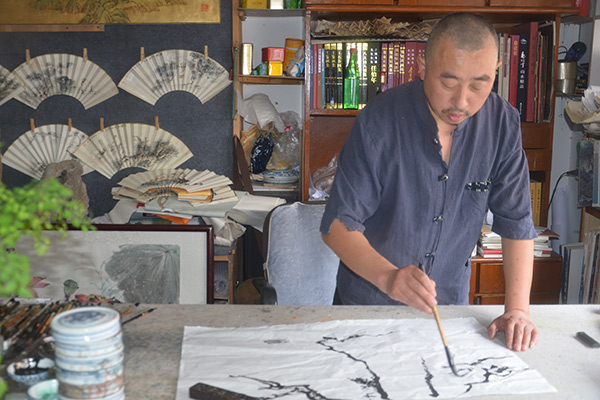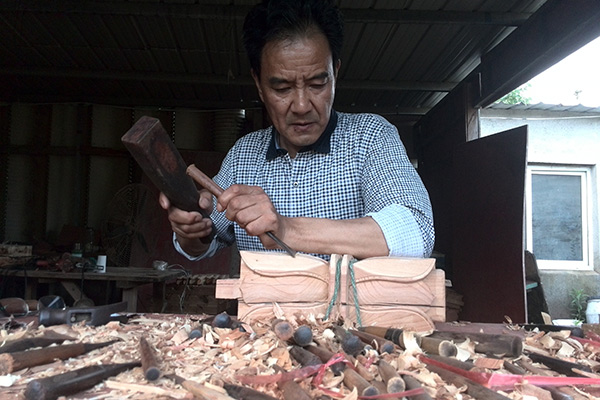
A night view of Xukou’s Xuhong bridge comprising three spans, the largest of which measures 75.7 meters. The bridge is a magnificent assembly of wood blocks of more than 400 cubic meters.[Photo provided to China Daily]
A town with some 90,000 residents, Xukou is a small place. It’s just one of the 15 divisions of Wuzhong, and Wuzhong is just one of the 10 district-level divisions of Suzhou. Xukou is 15 km away from the Suzhou downtown.
But Xukou’s importance is much larger. If you know the story of Suzhou, which goes that in 560 BC, during the Spring and Autumn period (770-476 BC), the lord of Wu commissioned a man called Wu Zixu (559-484 BC) to build a city for him in today’s Suzhou, you may sense some connection there: Xukou was named after Wu Zixu. And like Suzhou, it has a history dating back to more than 2,500 years ago.
Wu Zixu is regarded by people in Suzhou as a local hero. And Xukou has his tomb and temple.
Just as a rich history has left Suzhou with a bequest of canals, streets, stone bridges, and most distinctively, elegantly built gardens, it has endowed Xukou people with a traditional gift in creating the Suzhou-style gardens and brush paintings and calligraphy.
Of course, Xukou has factories with overseas investors, like elsewhere in Suzhou. The city, as a whole, contributes nearly 60 percent of the import and export of Jiangsu province. But Xukou continues to be best known for the architecture and art its people create.
Xukou is 15 km away from the city’s busy downtown, nestled in a quiet curve on the bank of Taihu Lake, the biggest lake in the Yangtze River Delta.
Beginning with the Ming Dynasty (1368-1644), scholars and artists liked to settle down there, to do their creative work while enjoying the scenery of its environment, and to make friends with the artisans and craftsmen from the neighborhood.
If the city of Suzhou is compared to a piece of art work, then it is Xukou that provides the city with the people to build and maintain its beauty — in garden courtyards, in brush paintings, in calligraphy scrolls, and in all their details expressive of the timeless folklore.
Xukou provides not just to Suzhou. It seems that anywhere in the world, if one can spot an element of Chinese art, that element may very well be from Xukou, at least in part.
Astor Court in the Metropolitan Museum of Art in New York City, a re-creation of a Ming Dynasty-style garden courtyard, was built by architects and craftsmen from Xukou, traditionally known as the Xiang Shan Guild.
“Our tradition actually goes much longer than Ming”, said Xue Lingen, one of the current leaders of Xiang Shan Guild.
“It was only from Ming it got famous, after many Xiang Shan architects and artisans were recruited for building the Forbidden City, the Ming imperial palace, in Beijing.”
In painting and calligraphy, Xukou wants to build branding power just as well.
From mid to late Ming Dynasty, brush painters (who were most likely also calligraphers) in Suzhou developed their own genre, called Wu Men (meaning Suzhou) art school.
In recent years, there has been a revival of that genre, in pure art and in art market as well.
In Beijing South Railway Station, perhaps the world’s largest hub for high-speed trains, the handed-painted paper-bamboo fans sold in the souvenir shop, some several thousand yuan apiece, are made in Suzhou, by artists including the many small studio owners based in Xukou.
Xukou now has a community of about 2,000 known brush painters, calligraphers, and specialists in mounting paintings, more than 600 art dealers, and several private art museums.
The small lakeside town has grown into a key bastion for the neo-Wu Men art school.

Artist Liu Xudong excels in painting on traditional folding fans.[Photo provided to China Daily]

Yu Wenxian, master of Luban lock, also known as Kongming lock, a detachable toy with nine wooden slips.[Photo provided to China Daily]
